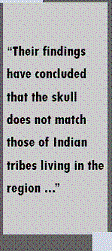Selected Reprints
Update on Kennewick Man
by Roger Thompson For many of us, our first extensive exposure to the story of Kennewick Man took place when Dr. James Chatters spoke on
recovering and examining these remains at our 2006 FOSA Annual Meeting. First uncovered in July 1996 on the banks of the
Columbia River, this discovery triggered a nine-year legal clash between scientists, the federal government and Native
American tribes who claim Kennewick Man as their ancestor.
The skeleton, one of the oldest and most complete ever found in North America, has been under close analysis since
courts sided with researchers in a legal battle with local Indian tribes who wanted the remains reburied without study.
While initial attempts were made by the local tribes to preclude study of the remains, the 9th U.S. Circuit Court of
Appeals ultimately ruled in favor of the scientists, allowing the bones to be studied.
Beginning in the Spring and Summer of 2006, a team of 20 forensic scientists, led by Dr. Doug Owsley, forensic
anthropologist for the National Museum of Natural History at the Smithsonian Institution in Washington, D.C., have been
studying the remains. Their findings have concluded that the skull does not match those of Indian tribes living in the
general area.
In addition to Dr. Owsley, other members of the team and their area of expertise include:
C. Loring Brace, professor of anthropology at the University of Michigan, has put some of the skeleton measurements
into a computer database, which allows him to study and track incremental changes in human populations over time. Professor
Brace believes Kennewick Man may have been a descendant of the ancient Jomon people of Asia.
Hugh Berryman, research professor at Middle Tennessee State University, is an anthropologist who is an expert in
interpreting skeletal injuries and figuring out how and why bones break. Professor Berryman studied how the bones broke
over time and determined, with other scientists, that Kennewick Man was deliberately buried by other people.
George Gill, professor of anthropology at the University of Wyoming specializes in determining the race of skeletons
through complex measurements of skulls.
Thomas Stafford Jr., geochemist from Lafayette, Colorado is using tiny bone fragments and powders from Kennewick Man
to determine what part of the bone might yield the most accurate age of the skeleton. In the past 10 years, Stafford has
developed a more precise radiocarbon dating test that is accurate within 20 years. Previously, the best dating technology
had a 500-year margin of error. He hopes to use his improved test on Kennewick Man's bones.

The scientists want to also try extracting DNA from Kennewick Man's bones or teeth, although Professor Stafford isn't
sure the technology is yet advanced enough. If successful, DNA testing could allow scientists to compare Kennewick Man's
genes with other populations around the world or tell scientists something about his physical traits.
Using an industrial CT scanner, Dr. Owsley has been able to study the skeleton in fine sections and also obtain a
better look at the spear point imbedded in Kennewick Man's hip. The point had previously been described as a Cascade point,
typical of the region, but Dr. Owsley indicated that is not the case. Cascade points tend to have two pointed ends and are
sometimes serrated while the point in Kennewick Man has a pointed end and a stem.
The discovery of Kennewick Man is dramatically reshaping beliefs about how humans populated the Americas. The research
concerning the skeletal remains continues, and the team of scientists will be finishing their reports and will write a book
or journal together. They anticipate that their team effort will serve as an example of how to study future discoveries.
Much of the story of Kennewick Man remains unwritten. At the same time, his skeleton may continue to raise more
questions about the past than it answers.